tijd
in
puppet_djt
Время объединения
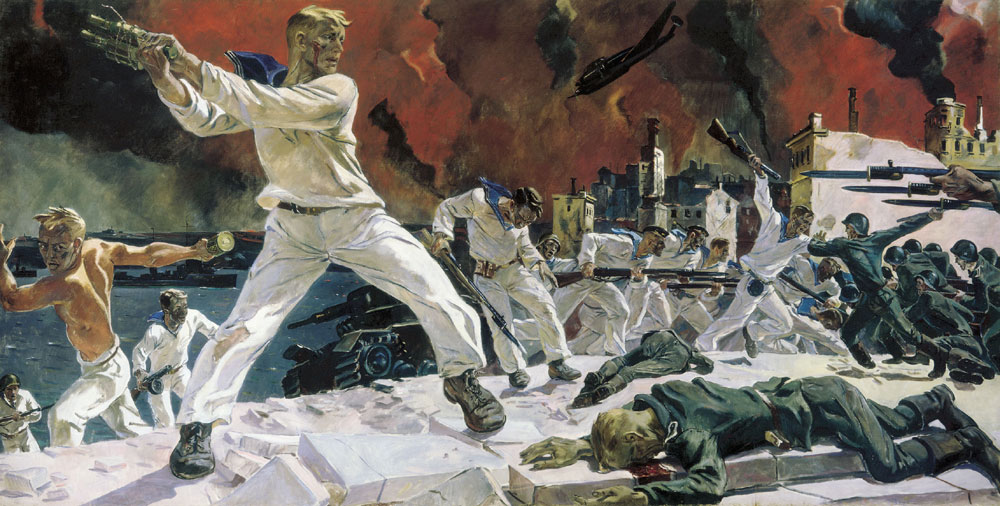
Новая историческая экскурсия - июль 1942. Главные мировые события в это время происходили, понятное дело, на фронтах войны.
Месяц начался с падения Севастополя.
Из справки начальника Управления Особых отделов НКВД СССР[217] B.C. Абакумова от 1 июля 1942 г.: «В беседе со мной […] командующий Черноморский флотом т. Октябрьский, находящийся в Новороссийске, о положении в Севастополе сообщил: […] в ночь с 30 июня на 1 июля противник ворвался в город и занял районы: вокзал, Исторический бульвар, Херсонесский аэродром и др. Оставшиеся бойцы дерутся героически, в плен не сдаются, при безвыходном положении уничтожают сами себя. […] Севастополя, как города, нет, разрушен»
https://military.wikireading.ru/69696
За взятие Севастополя Гитлер повышает Манштейна до звания генерал-фельдмаршала. Завершение долгого 250-дневного штурма города расчищает пути для дальнейшего наступления немецкой армии вглубь СССР.

2 июля 1942 Уинстон Черчилль успешно отбивается от попытки отстранить его от руководства на фоне разочарования ходом войны. Из речи Черчилля в британском Парламенте:
“I have never shared the view that this would be a short war, or that it would end in 1942. It is far more likely to be a long war. There is no reason to suppose that the war will stop when the final result has become obvious. The Battle of Gettysburg proclaimed the ultimate victory of the North, but far more blood was shed after the Battle of Gettysburg than before. At the same time, in spite of our losses in Asia, in spite of our defeats in Libya, in spite of the increased sinkings off the American coast, I affirm with confidence that the general strength and prospects of the United Nations have greatly improved since the turn of the year, when I last visited the President in the United States. The outstanding feature is of course the steady resistance of Russia to the invaders of her soil, and the fact that up to now at the beginning of July, more than halfway through the summer, no major offensive has been opened by Hitler upon Russia, unless he calls the present attacks on Kharkov and Kursk a major offensive. There is no doubt that the Russian Government and nation, wedded by the ties of blood, sacrifice and faith to the English speaking democracies of the West, will continue to wage war, steadfast, stubborn, invincible. I make no forecast of the future. All I know is that the Russians have surprised Hitler before and I believe they will surprise him again. Anyhow whatever happens they will fight on to death or victory. This is the cardinal fact at this time.“
https://www.ibiblio.org/pha/policy/1942/420702a.html

В июле 1942 все американские журналы выходят с американским флагом на обложке и лозунгом "United we stand". Эта акция для поднятия морального духа и продажи военных облигаций (war bonds) организована ассоциацией издателей (National Publishers Association) по просьбе министерства финансов, которое возглавляет Генри Моргентау.
В это время Моргентау - самый высокопоставленный еврей в правительстве Рузвельта.

2 июля 1942 New York Times помещает небольшую заметку на шестой полосе о систематическом уничтожении евреев на оккупированных территориях. Сообщение передано из Польши через польское правительство в изгнании.
The Polish Government in London has been urged in a report on the slaughter of 700,000 Jews in German-occupied territories to call on the Allied governments to adopt a policy of retaliation that will force the Germans to cease their killings.
https://www.nytimes.com/1942/07/02/archives/allies-are-urged-to-execute-nazis-report-on-slaughter-of-jews-in.html
Опросы американцев в середине июля 1942:
"Do you think the Jews have too much power and influence in this country?" Yes: 44% No: 41% No opinion: 15%
"Did you think Hitler did the right thing when he took away the power of the Jews in Germany?" Yes: 17% No: 62% No opinion: 17%
https://www.jstor.org/stable/2747042

4 июля 1942 - обращение Рузвельта на День независимости:
"On the desert sands of Africa, along the thousands of miles of battle lines in Russia, in New Zealand and Australia and the islands of the Pacific, in war-torn China and all over the seven seas, free men are fighting desperately-and dying-to preserve the liberties and the decencies of modern civilization. And in the overrun and occupied nations of the world, this day is filled with added significance, coming at a time when freedom and religion have been attacked and trampled upon by tyrannies unequaled in human history.
Never since it first was created in Philadelphia, has this anniversary come in times so dangerous to everything for which it stands. We celebrate it this year, not in the fireworks of make-believe but in the death-dealing reality of tanks and planes and guns and ships. We celebrate it also by running without interruption the assembly lines which turn out these weapons to be shipped to all the embattled points of the globe. Not to waste one hour, not to stop one shot, not to hold back one blow-that is the way to mark our great national holiday in this year of 1942.
To the weary, hungry, unequipped army of the American Revolution the Fourth of July was a tonic of hope and inspiration. So is it now. The tough, grim men who fight for freedom in this dark hour take heart in its message-the assurance of the right to liberty under God-for all peoples and races and groups and nations, everywhere in the world."
http://www.ibiblio.org/pha/policy/1942/420704b.html

В тот же день американские летчики совместно с британскими принимают участие в бомбардировкe немецких аэродромов в Голландии. Рейд получается наполовину провальным, но имеет символическое значение - американские военные впервые явным образом присутствуют на европейском театре военных действий.
Из воспоминаний Эйзенхауэра:
"Visits to the troops had not yet assumed their later proportions on my schedule; there were still relatively few units in the United Kingdom to visit. One of the earliest trips of this sort was in connection with our first offensive operation against the enemy - a bombing raid to celebrate July 4, 1942. The targets were four German airdromes in Holland. Six Bostons under command of Captain Charles C. Kegelman, included as part of a larger British formation, ran into severe flak and two failed to return. To mark our entry into the European fighting I took time to visit the crews immediately before the take-off, and talked with the survivors after their return."
https://archive.org/details/in.ernet.dli.2015.208955

4 июля 1942 печально известный приказ рассеяться ("Convoy is to scatter") от британского адмиралтейства способствует гибели конвоя PQ-17, который везет в Архангельск стратегические грузы от союзников.
"22 транспорта общим тоннажем более 142 тысяч тонн были потоплены немецкими подводными лодками и авиацией. На дно ушли 210 самолётов, 430 танков, 3350 автомобилей и 99 316 тонн других генеральных грузов."
https://ru.wikipedia.org/wiki/%D0%9A%D0%BE%D0%BD%D0%B2%D0%BE%D0%B9_PQ-17
Из-за этих катастрофических потерь Великобритания временно приостанавливает поставки грузов по северному пути.

Тем временем британские войска (с участием подкреплений из Индии, Новой Зеландии и других закоулков империи) участвуют в первом сражение при Эль-Аламейне. Затянувшееся на весь июль битва имеет стратегическое значение - не дает армии Роммеля прорваться к Александрии, а через нее - к ресурсам Ближнего Востока и Персидского залива. Нехватка топлива превращается в главную стратегическую повестку войны.
"Rommel’s grand goal was to push through Cairo, Palestine, Iraq, and Iran, en route to Baku and its oilfields. The convergence of the German forces in the Caucasus and Rommel’s forces at Baku would have achieved the grand prize and Hitler's objectives. It did not quite go as planned."
https://www.e-education.psu.edu/egee120/node/242

В Англии в июле 1942 Алан Тьюринг разрабатывает метод (получивший название "Turingery") для взлома шифрованных коммуникаций немецкого высшего командования. Изобретение сыграет прямую роль как в победе в войне, так и в создании компьютеров https://en.m.wikipedia.org/wiki/Turingery
The British codenamed the new machine Tunny. The Tunny teleprinter communications network, a harbinger of today's mobile phone networks, spanned Europe and North Africa, connecting Hitler and the Army High Command in Berlin to the front-line generals.
Turing's breakthrough in 1942 yielded the first systematic method for cracking Tunny messages. His method was known at Bletchley Park simply as Turingery, and the broken Tunny messages gave detailed knowledge of German strategy - information that changed the course of the war.
"Turingery was our one and only weapon against Tunny during 1942-3", explains ninety-one year old Captain Jerry Roberts, once section leader in the main Tunny-breaking unit known as the Testery.
"We were using Turingery to read what Hitler and his generals were saying to each other over breakfast, so to speak."
Turingery was the seed for the sophisticated Tunny-cracking algorithms that were incorporated in Tommy Flowers' Colossus, the first large-scale electronic computer.
With the installation of the Colossi - there were ten by the end of the war - Bletchley Park became the world's first electronic computing facility.
https://www.bbc.com/news/technology-18419691

6 июля 1942 Хаим Вейцман, президент Всемирной сионистской организации, по наводке Генри Моргентау встречается с генералом Джорджем Маршаллом, начальником штаба Армии США и будущим госсекретарем. Вайцман пытается уговорить администрацию Рузвельта надавить на Черчилля, чтобы Великобритания согласилась создать вооружённое формирование из евреев, проживающих в подконтрольной ей Палестине. Маршалл относится к предложению с симпатией, но Рузвельт от него отмахивается. Договоры с сионистами решено отложить на после войны.
“Saturday a Dr. Chaim Weizmann came to see me about the Jews in Palestine, specifically requesting that I use my influence to urge the British authorities to send Colonel Wingate from India to Palestine to rush the organization of Jewish manpower for such defensive work as they might be capable of.”
https://www.marshallfoundation.org/library/digital-archive/memorandum-for-field-marshal-sir-john-dill-3/

6 июля 1942 семья Анны Франк прячется от нацистов в тайном отсеке квартиры в Амстердаме, где проведёт 761 день.
Life for the eight people in the small apartment, which Anne Frank referred to as the Secret Annex, was tense. The group lived in constant fear of being discovered and could never go outside. They had to remain quiet during daytime in order to avoid detection by the people working in the warehouse below. Anne passed the time, in part, by chronicling her observations and feelings in a diary she had received for her 13th birthday, a month before her family went into hiding.
Addressing her diary entries to an imaginary friend she called Kitty, Anne Frank wrote about life in hiding, including her impressions of the other inhabitants of the Secret Annex, her feelings of loneliness and her frustration over the lack of privacy. While she detailed typical teenage issues such as crushes on boys, arguments with her mother and resentments toward her sister, Frank also displayed keen insight and maturity when she wrote about the war, humanity and her own identity. She also penned short stories and essays during her time in hiding.
https://www.history.com/topics/world-war-ii/anne-frank-1

7 июля 1942 Генрих Гиммлер утверждает программу медицинских экспериментов по стерилизации заключённых в лагерях смерти.
Himmler, architect of Hitler’s program to exterminate Europe’s Jewish population, convened a conference in Berlin to discuss the prospects for using concentration camp prisoners as objects of medical experiments. The other attendees were the head of the Concentration Camp Inspectorate, SS General Richard Glueks (hospital chief), SS Major-General Gebhardt and Professor Karl Clauberg (one of Germany’s leading gynecologists). The result of the conference was that a major program of medical experimentation on Jewish women at Auschwitz was agreed upon. These experiments were to be carried out in such a way as to ensure that the prisoners were not aware of what was being done to them. (The experimentation would take the form of sterilization via massive doses of radiation or uterine injections.) It was also decided to consult with an X-ray specialist about the prospects of using X rays to castrate men and demonstrating this on male Jewish prisoners. Adolf Hitler endorsed this plan on the condition that it remained top secret.
https://www.history.com/this-day-in-history/himmler-decides-to-begin-medical-experiments-on-auschwitz-prisoners
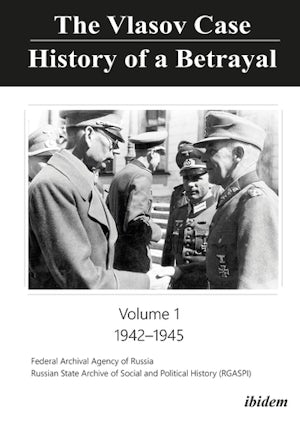
11 июля 1942 генерал Власов сдаётся в немецкий плен.
Власов без единого выстрела сдался немцам 11 июля 1942-го под Лугой - после полного окружения и разгрома вверенной ему 2-й Ударной армии. Полицаи отобрали у командарма револьвер и заперли его в деревенской бане.
"В открытой двери, - докладывал на следующий день командованию 18-й немецкой армии зондерфюрер Пельхау, - показался худой, высокий русский солдат, одетый в типичную длинную гимнастерку без знаков различия и без орденов. На лице, на горбатом носу - роговые очки. Солдат сказал на ломаном немецком: "Не стрелять, я генерал Власов". Вслед за этим он передал обер-лейтенанту фон Швердтнеру красное, переплетенное в кожу удостоверение с факсимильной подписью маршала Тимошенко".
После короткого допроса генерала перевезли в винницкий лагерь для военнопленных, находившийся в ведении разведотдела германской армии. Отдел отвечал за работу по идеологическому разложению личного состава РККА, а также по переманиванию советских военнослужащих на сторону нацистов.
https://ria.ru/20201207/vlasov-1587712365.html
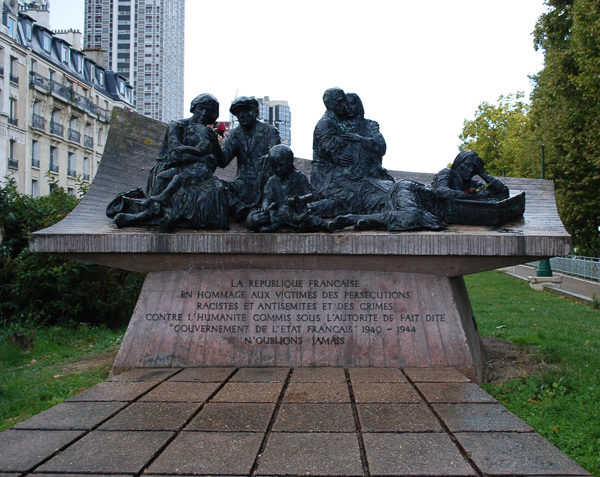
16-17 июля 1942 под давлением оккупационных властей правительство Виши во Франции проводит массовую облаву евреев (rafle du Vél'd'Hiv). Почти все арестованные, включая тысячи детей, будут позже уничтожены в лагерях смерти.
France was captured and occupied by Nazi Germany during World War Two and divided in two, with the Occupied zone governed directly by Germany and the rest, the so-called Zone libre, administered by the Vichy government under Marshall Philippe Pétain.
The Vichy government voluntarily adopted anti-Semitic laws.
The Rafle du Billet Vert was the first mass round-up of Jewish people in France, but not the only one.
The Vel’ d’Hiv’ round-up occurred just over one year later, when over 13,000 Jewish people, including 4,000 children, were arrested. They were held at the Vélodrome d'Hiver in Paris in deplorable conditions before being sent to Auschwitz.
In 1995, President Jacques Chirac apologised for the role French police and civil servants played in the event.
In 2017, President Emmanuel Macron admitted that the French state at the time was complicit in the round-up.
An exhibition showcasing the newly discovered photos of the Rafle du Billet Vert is currently on display outside the Gymnase Japy in Paris.
They will later be displayed at the Mémorial de la Shoah.
https://www.connexionfrance.com/French-news/Newly-surfaced-photos-show-wartime-mass-arrest-of-Jews-in-France

16 июля 1942 Гитлер прибывает в новую ставку верховного командования в Виннице. Украинская погода в это время стоит жаркая (+45), в жарком бункере Гилер дополнительно страдает от гриппа с высокой температурой. Он ведёт себя хаотично и совершает роковую для себя ошибку, принимая решение о том, чтобы разбить южную группу войск на две части с одновременным наступлением на Сталинград и Кавказ (нефтяные месторождения Баку).
Believing that the main Soviet threat had been eliminated, desperately short of oil and needing to meet all the ambitious objectives of Case Blue, Hitler made a series of changes to the plan in Führer Directive No. 45 on July 23, 1942:
- reorganized Army Group South into two smaller Army Groups, A and B;
- directed Army Group A to advance to the Caucasus and capture the oil fields (Operation Edelweiß);
- directed Army Group B to attack towards the Volga and Stalingrad (Operation Fischreiher).
There is no evidence Hitler was opposed by, or received complaints from Franz Halder, Chief of the General Staff, or anyone else, about the directive until August 1942. The new directive created enormous logistical difficulties, with Hitler expecting both Army Groups to advance along different routes. Logistics lines were already at breaking point with ammunition and fuel shortages most apparent and it would be impossible to advance using the conservative supply rates he demanded. The divergence of the Army Groups would also open a dangerous gap between the Armies, which could be exploited by the Soviets.
https://en.m.wikipedia.org/wiki/Case_Blue#Splitting_of_Army_Group_South

Работа над американской атомной бомбой находится в это время в зачаточном состоянии. Артур Комптон из Чикагского университета, которому было изначально было поручено руководство проектом, поручает Роберту Оппенгеймеру из Калифорнии организовать работу.
В июле 1942 Оппенгеймер собирает в Беркли совещание лучших умов среди американских физиков, будущих участников Манхэттенского проекта. В атмосфере свободной дискуссии они обсуждают перспективы создания бомбы и необходимые для этого ресурсы.
Oppenheimer’s first step on the long road to the development of ‘the gadget,’ as it came to be called, that burst over New Mexico’s Jornada del Muerto (‘Journey of Death,’ a stretch of waterless desert) in July 1945, and to the bombs nicknamed Little Boy and Fat Man, which destroyed Hiroshima and Nagasaki that August, was to arrange the Berkeley seminar. He secured two dormer rooms at the top of Le Conte Hall beginning the second week in July 1942, nearly three years to the day before the eventual test of the gadget at the desert site that became known as Trinity. Oppenheimer referred to the study group as ‘our galaxy of luminaries.’
One of the luminaries was Robert Serber, a colleague and close friend of Oppenheimer’s who the following year at the Los Alamos, N.M., research site would reprise the Berkeley seminar in five introductory lectures to the first scientists to join the laboratory. The notes for the lectures, collected as The Los Alamos Primer, would later be required reading for incoming scientists on the project. According to Serber, ‘The purpose of the 1942 summer conference at Berkeley was to discuss the whole state of the theory, to make an independent assessment of whether the bomb was a reasonable possibility, and to assess how well everything was known.’
Oppenheimer’s gathering resembled in microcosm the massive organization of scientific genius that he directed at the laboratory a year later. While different Berkeley attendees would be assigned specific problems or tasks, they also enjoyed a freewheeling exchange of thought and debate. Barriers to communication were anathema to Oppenheimer and his contemporaries. They believed passionately in the uninterrupted flow of ideas and information among individuals and institutions as well as nations. That tenet had been one of the prime reasons for the dramatic advancement of modern physics. It also accounted for the reason the luminaries feared Heisenberg and his colleagues in Germany. They knew what Heisenberg knew. <...>
Besides Oppenheimer, Serber and Teller, the principals at the summer session at Berkeley were Hans Bethe, Felix Bloch, Stanley Frankel, Emil Konopinski, Richard Tolman and John H. Van Vleck. Bethe, Bloch and Van Vleck would later win the Nobel Prize. All were young men of extraordinary intelligence and talent whose capacity for creative imaging of the physical universe was as great as could be found in any group at that time. During the conference they enjoyed what may have been among the few halcyon days of the entire Manhattan Project.
Robert Serber later reflected on the Berkeley participants’ confidence, if not nonchalance, as they entered the meeting. ‘By summer [1942] things were pretty well in hand,’ he wrote. ‘The uncertainties were in the experimental figures, the cross sections, the number of neutrons per fission and whatnot. But they didn’t seem large enough to make a difference between failure and success. They might determine whether the bomb would be a little bigger or a little smaller. I think we were lucky that some of the answers came out within ten percent of the final ones.’ <...>
Oppenheimer, who was daily becoming more accustomed to his new role, also saw what was needed. He was convinced after the Berkeley meeting ‘that a major change was called for in the work on the bomb itself. We needed a central laboratory devoted wholly to this purpose, where people could talk freely with each other, where theoretical ideas and experimental findings could affect each other, where the waste and frustration and error of the many compartmentalized studies could be eliminated, where we could begin to come to grips with chemical, metallurgical, engineering, and ordnance problems that had so far received no consideration. We therefore sought to establish this laboratory for a direct attack on all the problems inherent in the most rapid possible development and production of atomic bombs.’
https://www.historynet.com/weaponry-scientists-meet-at-berkeley-to-lay-foundation-to-build-an-atomic-bomb.htm
Во время дискуссий Эдвард Теллер высказывает предположение, что атомный взрыв может вызвать возгорание атмосферы (и, следовательно, уничтожение всей жизни на Земле). Оценочные вычисления Ханса Бете опровергают вероятность такого эффекта, но Оппенгеймер не может выпустить его из головы. Он садится в поезд и едет на встречу с Комптоном, который в это время отдыхает в своем загородном доме в Мичигане. На берегу мичиганского озера Комптон и Оппенгеймер обсуждают, следует ли продолжать проект несмотря на его риски и решают продолжить, перепроверив вычисления.
Комптон записывает свои мысли во время разговора: "Was there really any chance that an atomic bomb would trigger the explosion of the nitrogen in the atmosphere or of the hydrogen in the ocean? This would be the ultimate catastrophe. Better to accept the slavery of the Nazis than to run a chance of drawing the final curtain on mankind! Oppenheimer’s team must go ahead with their calculations. Unless they came up with a firm and reliable conclusion that our atomic bombs could not explode the air or the sea, these bombs must never be made."
Marlene Dietrich, Irene Dunne, Rita Hayworth, Rosalind Russell and Loretta Young at the Hollywood Bowl, 1942. pic.twitter.com/9gXESvzlKC
- Tanja (@T__twitt) March 22, 2017
17-18 июля 1942 в Калифорнии выступает со своим вторым концертом для фортепиано с оркестром недавно переехавший туда Сергей Рахманинов.
He had come to be regarded in Los Angeles as one of the greatest pianists and composers of his time. The capstone of it all was Rachmaninoff’s Hollywood Bowl debut-also his last appearance in the city-in two performances of his Second Concerto on July 17 and 18. “It was an occasion,” wrote Isabel Morse Jones. “The large audience was aware of its significance and offered ... the revered pianist, who now makes his home here, homage and appreciation.” The orchestra, too, “greeted him by rising when he came in... It was resplendent music Rachmaninoff made last night.” As Jones noted, the Rachmaninoffs had just moved to Los Angeles. In May they rented the house at 9941 Tower Lane in Beverly Hills and, enjoying the atmosphere, decided immediately to buy a house nearby at 610 North Elm Drive.
https://www.academia.edu/16092712/Rachmaninoff_and_Stravinsky_in_Los_Angeles_to_1943

19 июля 1942 симфонический оркестр NBC под руководством Тосканини исполняет седьмую «Ленинградскую» симфонию Шостаковича. Портрет Шостаковича в пожарном шлеме - на обложке журнала “Time”.
Following tremendous publicity, and in a spirit reflective of the enthusiasm and the gratitude that the people of this nation feel today toward Russia, defending in oceans of blood humanity's cause, the American premiere of the much-heralded Seventh Symphony of Dmitri Shostakovich, musical banner-bearer of his people, was given yesterday afternoon in Radio City by the NBC Symphony Orchestra, under the leadership of Arturo Toscanini, to shattering applause.
https://www.nytimes.com/1942/07/20/archives/shostakovich-7th-has-us-premiere-russians-war-symphony-as-offered.html
Not since the first Manhattan performances of Parsifal (in 1903) had there been such a buzz of American anticipation over a piece of music.
Last month a little tin box, no more than five inches around, arrived in the U.S. In it were 100 feet of microfilm-the photographed score of the Seventh Symphony. It had been carried by plane from Kuibyshev to Teheran, by auto from Teheran to Cairo, by plane from Cairo to New York. Photographers went to work printing from the film. In ten days they reproduced four fat volumes, 252 pages in all, of orchestral score.
https://csoarchives.files.wordpress.com/2014/05/time-magazine-article-1942.pdf
Но кроме серьезной музыки по радио передают и развлекательную. Самый популярный хит июля 1942 - ковбойский фокстрот “Jingle, Jangle, Jingle”.
I got spurs that jingle, jangle, jingle
As I go ridin' merrily along
And they sing, "Oh, ain't you glad you're single"
And that song ain't so very far from wrong
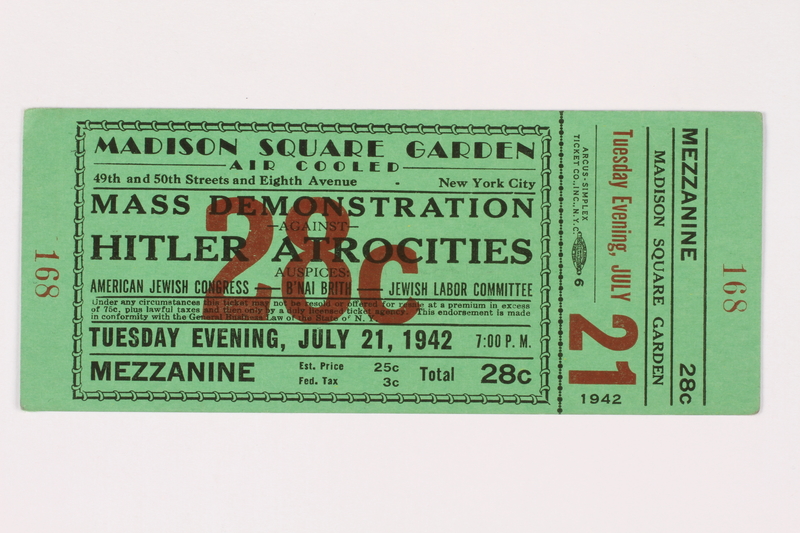
21 июля 1942 еврейские организации проводят 20-тысячный антигитлеровский митинг в Madison Square Garden в Нью-Йорке. На митинге зачитывается обращение Рузвельта:
"Americans who love justice and hate oppression will hail the solemn commemoration in Madison Square Garden as an expression of the determination of the Jewish people to make every sacrifice for victory over the Axis powers. Citizens, regardless of religious allegiance, will share in the sorrow of our Jewish fellow citizens over the savagery of the Nazis against their helpless victims. The Nazis will not succeed in exterminating their victims any more than they will succeed in enslaving mankind. The American people not only sympathize with all victims of Nazi crimes but will hold the perpetrators of these crimes to strict accountability in a day of reckoning which will surely come."
https://www.jta.org/archive/roosevelt-pledges-american-people-will-hold-nazis-responsible-for-atrocities-against-jews
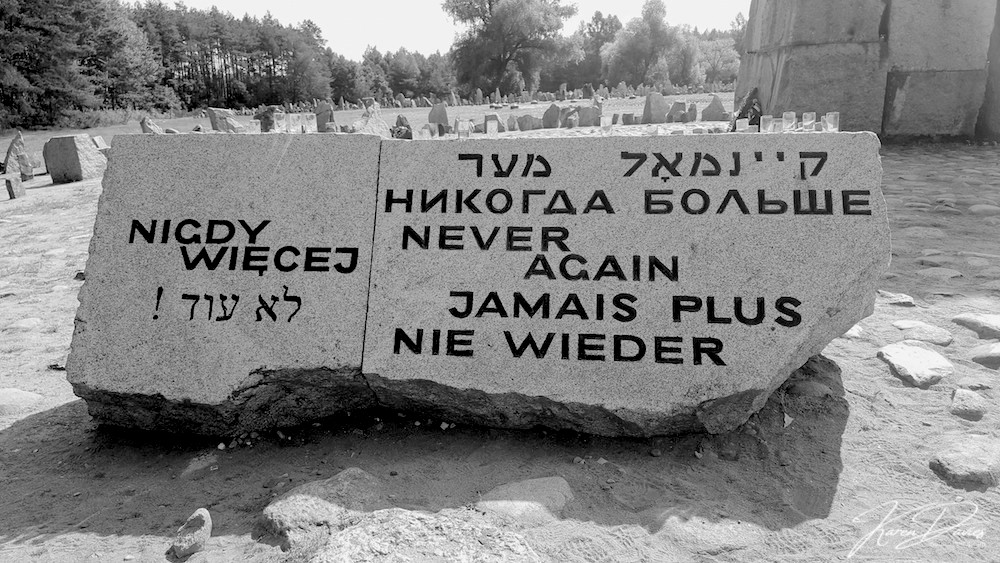
22 июля 1942 на территории оккупированной Польши по приказу Гиммлера начинается массовая программа доставки евреев в лагерь смерти Треблинка.
Himmler promoted the camp commandant, Rudolph Hoess, to SS major and ordered that the Warsaw ghetto (the Jewish quarter constructed by the Nazis upon the occupation of Poland, enclosed first by barbed wire and then by brick walls), be depopulated-a “total cleansing,” as he described it-and the inhabitants transported to what was to become a second extermination camp constructed at the railway village of Treblinka, 62 miles northeast of Warsaw.
Within the first seven weeks of Himmler’s order, more than 250,000 Jews were taken to Treblinka by rail and gassed to death, marking the largest single act of destruction of any population group, Jewish or non-Jewish, civilian or military, in the war. Upon arrival at “T. II,” as this second camp at Treblinka was called, prisoners were separated by sex, stripped, and marched into what were described as “bathhouses,” but were in fact gas chambers. T. II’s first commandant was Dr. Irmfried Eberl, age 32, the man who had headed up the euthanasia program of 1940 and had much experience with the gassing of victims, especially children. He compelled several hundred Ukrainian and about 1,500 Jewish prisoners to assist him. They removed gold teeth from victims before hauling the bodies to mass graves. Eberl was relieved of his duties for “inefficiency.” It seems that he and his workers could not remove the corpses quickly enough, and panic was occurring within the railway cars of newly arrived prisoners.
By the end of the war, between 700,000 and 900,000 would die at either Treblinka I or II. Hoess was tried and sentenced to death by the Nuremberg Tribunal. He was hanged in 1947.
https://www.history.com/this-day-in-history/deportations-from-warsaw-ghetto-to-treblinka-begin
22 июля 1942 на экраны выходит фильм “Mrs. Miniver” о жизни британской домохозяйки, разрушенной войной. Фильм получит шесть Оскаров и, по словам Черчиля, в деле победы будет стоить пяти линкоров. Не упоминания немцев явным образом, фильм сможет вдохновить американцев и британцев в тылу и на фронте на войну до победного конца.
A scene near the end - in which a vicar delivers a sermon in a bombed-out church - was rewritten by Wyler and Henry Wilcoxon, the actor playing the vicar, the night before it was filmed. President Roosevelt requested that it be translated into several languages and air-dropped over German-occupied territory; it was also reprinted in Time and Look magazines.
The ultimate endorsement came from an unlikely source. Nazi Propaganda Minister Joseph Goebbels wrote that Mrs Miniver “shows the destiny of a family during the current war, and its refined powerful propagandistic tendency has up to now only been dreamed of. There is not a single angry word spoken against Germany; nevertheless the anti-German tendency is perfectly accomplished.”
https://www.bbc.com/culture/article/20150209-the-film-that-goebbels-feared
Монолог пастора в разрушенной бомбежками церкви из финальной сцены фильма:
“Because this is not only a war of soldiers in uniform. It is a war of the people, of all the people, and it must be fought not only on the battlefield but in the cities and in the villages, in the factories and on the farms, in the home, and in the heart of every man, woman, and child who loves freedom.
Well, we have buried our dead, but we shall not forget them.
Instead they will inspire us with an unbreakable determination to free ourselves and those who come after us from the tyranny and terror that threaten to strike us down.
This is the people's war!
It is our war!
We are the fighters! Fight it, then! Fight it with all that is in us!
And may God defend the right.”

24 июля 1942 Илья Эренбург публикует в "Красной Звезде" знаменитую статью "Убей!".
"Мы поняли: немцы не люди. Отныне слово «немец» для нас самое страшное проклятье. Отныне слово «немец» разряжает ружье. Не будем говорить. Не будем возмущаться. Будем убивать. Если ты не убил за день хотя бы одного немца, твой день пропал. Если ты думаешь, что за тебя немца убьет твой сосед, ты не понял угрозы. Если ты не убьешь немца, немец убьет тебя. Он возьмет твоих и будет мучать их в своей окаянной Германии. Если ты не можешь убить немца пулей, убей немца штыком. Если на твоем участке затишье, если ты ждешь боя, убей немца до боя. Если ты оставишь немца жить, немец повесит русского человека и опозорит русскую женщину. Если ты убил одного немца, убей другого - нет для нас ничего веселее немецких трупов. Не считай дней. Не считай верст. Считай одно: убитых тобою немцев. Убей немца! - это просит старуха-мать. Убей немца! - это молит тебя дитя. Убей немца! - это кричит родная земля. Не промахнись. Не пропусти. Убей!"
https://0gnev.livejournal.com/144733.html

24 июля 1942 Воронежско-Ворошиловградская операция завершается серьезным продвижением немецких войск по направлению к Сталинграду. Последовательно взяты Воронеж, Ворошиловград (нынешний Луганск) и Ростов-на-Дону.
В целом потери трех фронтов в продолжавшейся 27 дней Воронежско-Ворошиловградской операции составили свыше 568 тыс. чел. (среди них немалая часть - пленные), 2436 танков, 13 716 орудий и минометов, 783 самолета. По интенсивности потерь - 21 тыс. чел., 90 танков, 508 орудий и минометов, 29 самолетов в сутки - эта операция является одной из самых неблагоприятных для Красной Армии за всю войну. По урону она превзошла Харьковское сражение и Керченскую операцию вместе взятые, став самым тяжелым поражением Красной Армии в 1942 г.
http://www.hrono.ru/sobyt/1900sob/1942voronezh.php

28 июля 1942 Сталин выпускает знаменитый приказ 227 "Ни шагу назад!". Приказ зачитывается в войсках, но не публикется в печати.
"Враг бросает на фронт все новые силы и, не считаясь с большими для него потерями, лезет вперед, рвется в глубь Советского Союза, захватывает новые районы, опустошает и разоряет наши города и села, насилует, грабит и убивает советское население. Бои идут в районе Воронежа, на Дону, на юге у ворот Северного Кавказа. Немецкие оккупанты рвутся к Сталинграду, к Волге и хотят любой ценой захватить Кубань, Северный Кавказ с их нефтяными и хлебными богатствами. Враг уже захватил Ворошиловград, Старобельск, Россошь, Купянск, Валуйки, Новочеркасск, Ростов-на-Дону, половину Воронежа. Часть войск Южного фронта, идя за паникерами, оставила Ростов и Новочеркасск без серьезного сопротивления и без приказа Москвы, покрыв свои знамена позором. <…> Мы потеряли более 70 миллионов населения, более 800 миллионов пудов хлеба в год и более 10 миллионов тонн металла в год. У нас нет уже теперь преобладания над немцами ни в людских резервах, ни в запасах хлеба. Отступать дальше - значит загубить себя и загубить вместе с тем нашу Родину."
https://ru.wikisource.org/wiki/%D0%9F%D1%80%D0%B8%D0%BA%D0%B0%D0%B7_%D0%9D%D0%9A%D0%9E_%D0%A1%D0%A1%D0%A1%D0%A0_%D0%BE%D1%82_28.07.1942_%E2%84%96_227
В качестве мер для остановки отступления предлагаются заградотряды НКВД и штрафные батальоны.

30 июля 1942 в Лондоне проходит совещание Объединённого комитета начальников штабов США и Великобритании. Британская сторона предлагает отложить план совместной высадки в Европу (операцию "Sledgehammer"), а вместо этого осуществить высадку в Северную Африку (операцию "Torch"). Маршалл не в восторге от этого плана, но вынужден подчиниться прямому приказу Рузвельта.
Senior U.S. commanders expressed strong opposition to the landings and after the western Allied Combined Chiefs of Staff (CCS) met in London on 30 July, General Marshall and Admiral Ernest King declined to approve the plan. Marshall and other U.S. generals continued to advocate Operation Sledgehammer, which the British rejected. After Prime Minister Churchill pressed for a landing in French North Africa in 1942, Marshall suggested instead to President Roosevelt that the U.S. abandon the Germany first strategy and take the offensive in the Pacific. Roosevelt said it would do nothing to help Russia. With Marshall unable to persuade the British to change their minds, President Roosevelt gave a direct order that Torch was to have precedence over other operations and was to take place at the earliest possible date, one of only two direct orders he gave to military commanders during the war. Torch met the British objective of securing victory in North Africa and the American objective to engage in the fight against Nazi Germany on a limited scale.
https://en.m.wikipedia.org/wiki/Operation_Sledgehammer
Дело оставалось за малым - объяснить Сталину, почему тот должен продолжать войну несмотря на отсутствие обещанного второго фронта в Европе. Черчиль берет эту непростую дипломатическую задачу на себя.
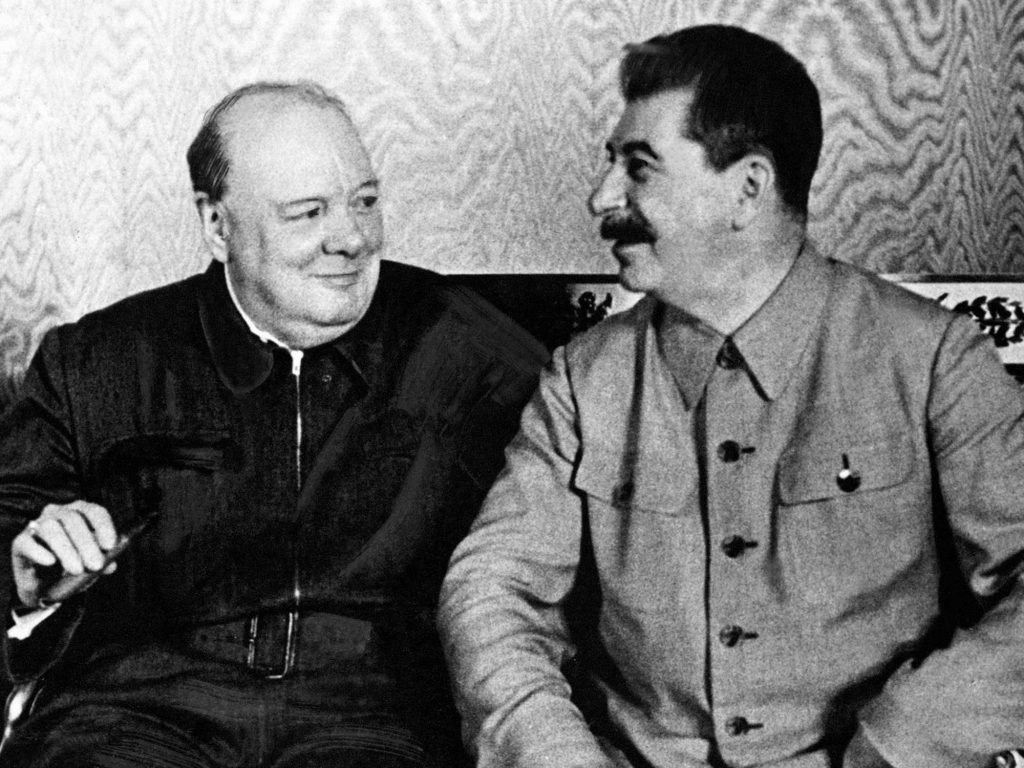
31 июля 1942 Черчиль предлагает Сталину личную встречу и получает в ответ приглашение приехать в Москву.
«Я хотел бы, чтобы Вы пригласили меня встретиться с Вами лично в Астрахани, на Кавказе или в каком-либо другом подходящем месте. Мы могли бы совместно обсудить вопросы, связанные с войной, и в дружеском контакте принять совместные решения. Я мог бы сообщить Вам планы наступательных операций в 1942 г., согласованные мною с Президентом Рузвельтом. Я привез бы с собой моего начальника Имперского генерального штаба.»
http://www.hrono.ru/libris/stalin/sc42_58.php
«Настоящим от имени Советского Правительства приглашаю Вас прибыть в СССР для встречи с членами Правительства.
Я был бы весьма признателен Вам, если бы Вы смогли прибыть в СССР для совместного рассмотрения неотложных вопросов войны против Гитлера, угроза со стороны которого в отношении Англии, США и СССР теперь достигла особой силы.
Я думаю, что наиболее подходящим местом нашей встречи была бы Москва, откуда мне, членам Правительства и руководителям Генштаба невозможно отлучиться в настоящий момент напряженной борьбы с немцами.»
http://www.hrono.ru/libris/stalin/sc42_60.php
Дружеское объединение союзников - необходимое условие для перелома хода войны.